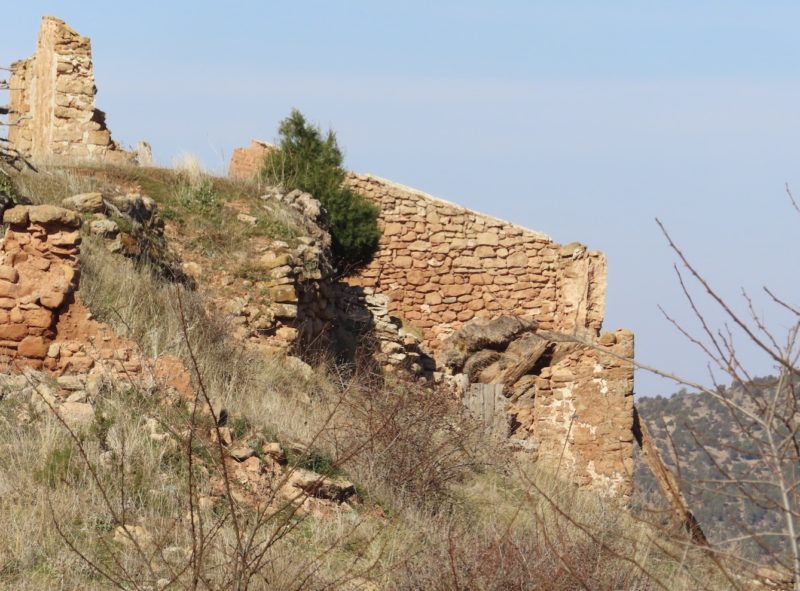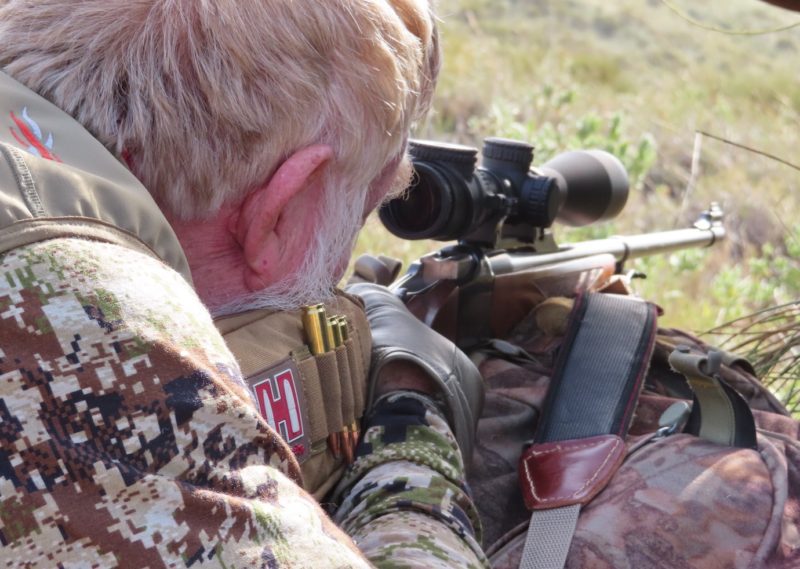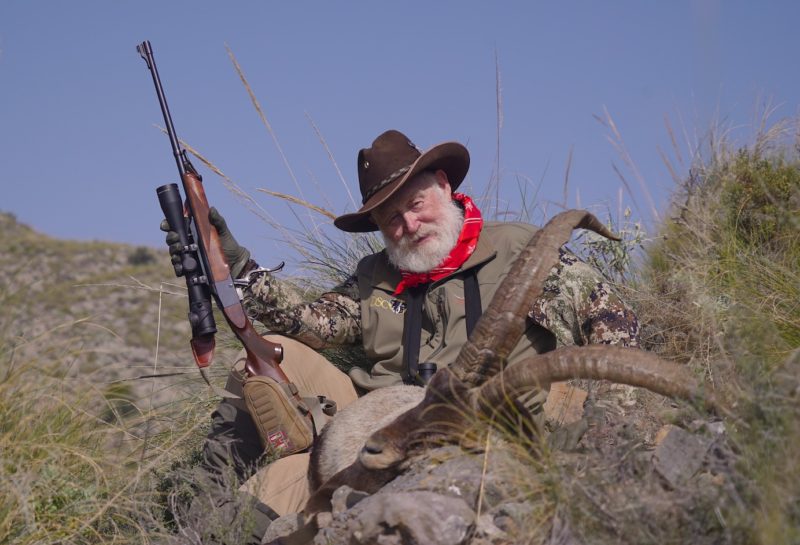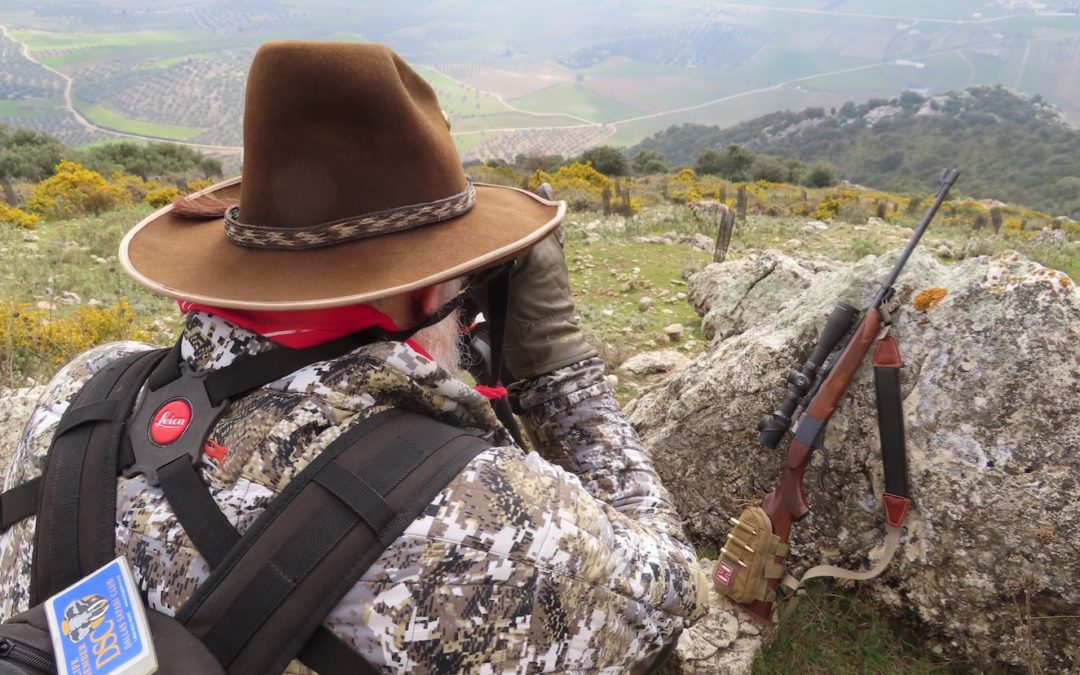Standing behind my guide, using him to hide any movement, I raised my Leica binos to get a better look. The younger male’s horns were about a foot long, but nicely massive at the bases. Watching, it became obvious, surprisingly, he had not yet seen us. Nearly eight hundred yards separated the ridge he was on and where we were hiding. Twenty minutes earlier from a much great distance we had spotted not only the ram that was now sky-lined, but three other ibex, all males.
Upon initially seeing them, the Mediterranean Sea and southeastern Spain shoreline serving as background, my guide started planning our stalk after looking through his spotting scope to confirm at least one of them was a “shooter.” As Alfonso surveyed the terrain for an approach he spoke, “Two on left, really nice! Biggest one, we want!”
He glanced back at me and instructed “Look!” I did. The ibex were difficult to see. We were looking directly into the early morning sun. I finally spotted the one Alfonso was referring to. He had just laid down and only his head and tall, backswept horns were visible above the brush.
“We go…” said the guide. I glanced back at Dustin Blankenship, cameraman for our DSC’s Trailing the Hunter’s Moon. “Gonna be tough, trying to film into the sun!” was his only comment. I nodded. Not only did I know the filming was going to be tough, I would likely be looking and shooting into the sun. As we headed in the direction of the now bedded ibex I questioned Alfonso if there might be another approach that would put us where the sun would be at our back or at least at a quartering angle. He shook his head and commented the only approach would be direct, sun in our face, taking advantage of the deep cut we were about to drop into, which should put us within five-hundred yards of our quarry. Cautiously we moved forward.
Earlier that morning we had met Alfonso at a pre-dawn roadside restaurant. We had been introduced to him by our outfitter, Pedro Alacron with Pedriza. My Spanish ibex hunt had been set up by Scott Kendrix who owns Global Pursuit (www.gphunts.com).
Said Pedro, “Alfonso knows more about southeastern ibex and probably ibex in Spain than just about anyone. He’s been guiding for many years. He told me last night when we talked that if you take an ibex with him it will be the three-thousand, six hundred and fifty-first ibex he has guided hunters to.
Over the years Alfonso had guided many of the world’s most famous hunters. Too, we’ll be hunting property he controls. The large estancia allows the taking of only one ibex each year. We’ll be looking for one that is at least ten-years old.”

The terrain reminded Larry of western Texas and New Mexico.
Driving along the edge of the Mediterranean I was impressed with the small villages, how clean they were, and the great number of extended “greenhouses.” Pedro explained that the area was known for the vegetables it produces.
We were within about an hour of the property when I noticed Pedro got very quiet and had a pained expression on his face. Finally, he spoke. “I’m not feeling very good. I think I’m going to stop and have you go with Alfonso for this morning’s hunt. I will meet up with you later this afternoon.”
We left Pedro in a small seaside village, wished him well, and proceeded to Alfonso’s hunting area.
The terrain was rolling and brushy with deep rocky canyons. Alfonso explained that just beyond what we could see was a steep, rocky drop to the sea. “Ibex hang out on the steep bluffs during the day, but early and late feed in the rolling hills we are looking at.”
During our effort to get closer to the ibex, I noticed much of the terrain as well as the vegetation we were walking through reminded me of western Texas and southern New Mexico.
Suddenly, Alfonso held up his hand indicating for us to stop as we walked up a ridge. He whispered that we would soon be able to see the ibex.
“We’ll crawl up. Be ready to shoot.” He looked back at me, “Are you certain you can shoot long range with your rifle?” I was carrying my Ruger Number 1 chambered in .275 Rigby, topped with a 2.5-12.5x Trijicon AccuPoint. I would be shooting Hornady 140-grain Soft Points. I nodded an affirmative, “Before leaving Texas I spent much time at the range on my property shooting out to 700 yards. I feel comfortable taking a shot from a good solid rest out to at least 500.”
“We will be close to that distance, maybe a little more,” said Alfonso. “Follow me!”
I belly-crawled to the top of the ridge, pushing my backpack ahead of me to use as a solid rest. Near the crest I inched my way next to Alfonso, who was using a small bush for cover. I moved to his left, where if indeed I had a shot, it would have me shooting left-handed rather than my usual right. I was thankful that, many years ago, I taught myself to shoot from both sides.
“Do you see them?” questioned Alfonso. He continued, “They are bedded about a third of the way from the top on the left third, side of the ridge. The big one we are after is second from the left and slightly lower than the other two, but all that can be seen of him right now are his head and horns.”
I looked back at Dustin. He had a quizzical look on his face and shrugged his shoulders indicating he had yet to see the ibex. I moved slightly to my left to glass the distant hillside and had great difficulty locating the ibex, partly due to the sun shining directly into my eyes and binos.
“Don’t see them,” I replied. Just then the sun glinted off of one of the ibex’s horns. I removed my brown western hat and held it so it provided shade on my binos. “OK, now I see them! There are at least three, maybe more.The one that looks biggest to me is more or less in the middle, but lower than the other two I can see.” I heard Alfonso say that was the one he wanted me to shoot.

Larry takes careful aim in preparation for the 500+ yard shot.
I positioned the Ruger single-shot on my pack. The only way I could see the ibex was to use my hat to shade the scope. Finally, I located the biggest of the three. I looked over my shoulder. Dustin was holding the camera at his side. “I have no clue where they are!” he groaned in exasperation.
With that I asked Alfonso to help Dustin locate the ibex which, according to our rangefinder, were 527 yards away. I handed Dustin my binos and Alfonso set up his spotting scope and trained them on the bedded animals. The sun continued to shine directly into our eyes, making seeing the ibex all the more near difficult.
I waited for Dustin to find the ibex and then get his camera set up on them. No sooner had he done so than the ibex got up and started moving around, thankfully feeding slight toward us.
“Any way to get closer?” asked Dustin.
“We are as close as we are going to be able to get,” replied Alfonso. “There is no cover tall enough for us to hide behind to get any closer. Nor is there another approach.”
“Oh…OK,” sighed the cameraman. “Not going to be great in your face footage, but then I guess this is Spanish ibex hunting! Give me as much time as you can before shooting, then tell me before you shoot.”
I squirmed to get into a rock-solid shooting position and asked Alfonso to not only keep an eye on the moving ibex, but also to position my hat so it would shade my eyes allowing me to focus on the distant ibex and place him in the crosshairs. I was appreciative too that the ibex I hoped to take had horns at least four or five inches longer than the other two, and more massive to boot.

Larry with his beautiful ibex.
“He’s the one in front of the others, slightly below and to the right,” Said Alfonso. It was the one I had the crosshairs on. Earlier I consulted the range card given me by Tim Fallon with the FTW Ranch where they teach S.A.A.M. (Sportsman All Weather All Terrain Marksmanship). It helped me make the appropriate scope reticle adjustments for 500 yards. Thankfully there was virtually no wind. What mirage there was, drifted straight up rather than to either side. There was no apparent reason to adjust for wind.
The Trijicon’s green dot and crosshairs were planted just behind the near broadside ibex’s shoulder. “Get ready, I’m about to shoot!” I said to Dustin as I pushed the Ruger’s tang safety to fire, took a deep breath let it all out and started squeezing the trigger.
Soon as the shot went off… “He’s hit hard!” said Alfonso who was looking through his spotting scope. Even though I doubted there would be a chance for a second shot, I shoved in a fresh round. Before I could even try to get set up for a second shot, about three accelerated heart beats after pulling the trigger, I heard my guide say, “He’s down!”
Even so I kept the crosshairs on the distant fallen ibex and waited for any movement. There was none!
I turned and accepted Alfonso’s extended congratulatory hand. “Number three thousand six hundred and fifiy-one?” I questioned. Alfonso beamed broadly and nodded approvingly.
It took a little bit of time to cross the deep canyon between us and where my ibex lay on a fairly steep slope. At the Sierra Nevada ibex’s side, I marveled at the twelve-year old ibex’s gorgeous upward and then backward swept horns. His right side was slightly broomed, otherwise he was perfect. Handsome cape, tan and dark color pattern typical of the subspecies, I could hardly wait to get his horns and cape to Double Nickle Taxidermy (www.doublenickletaxidermy.com) back in Texas and then into my office.
After photos, removing the cape and then taking care of what Alfonso said was delicious meat, we headed down the mountain to go find Pedro. From there we’d check on Scott Sachs and his wife Wendy, who had journeyed to Spain with me and were hunting on other property farther up the mountain range.
Afterward, I would continue on to the second leg of my Spanish ibex quest, my quest for a Beceite ibex.
“DSC’s Trailing the Hunter’s Moon,” which appears year around on Pursuit Channel, can also be seen at no cost on www.pursuituptv.com.

